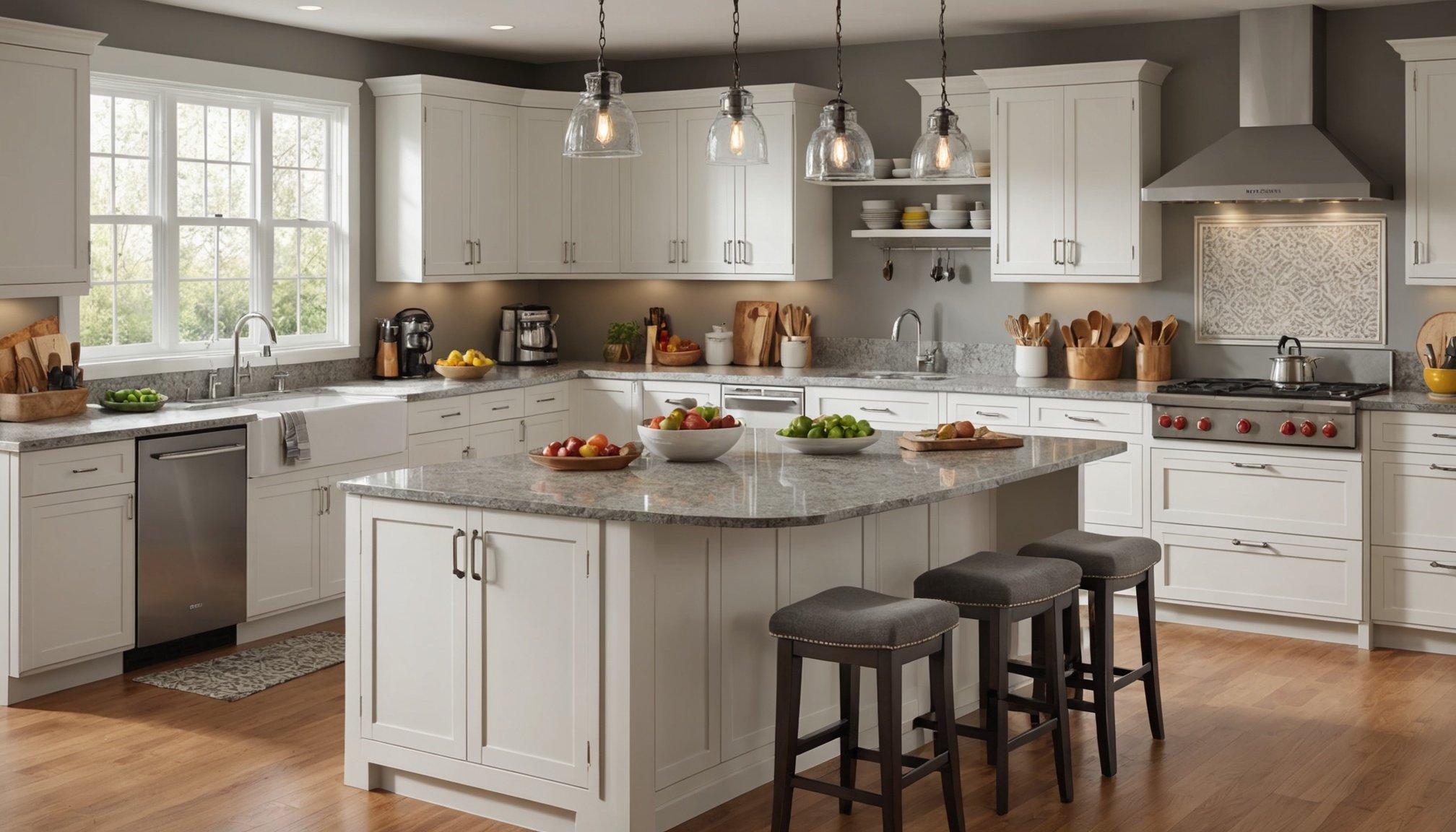Finding the ideal kitchen counter height is more than just a design choice; it directly impacts your cooking experience and overall well-being. A comfortable counter height can enhance your culinary tasks, reducing strain and improving ergonomics. Additionally, it plays a role in weight management by promoting healthy cooking habits. Explore how the right measurements can transform your kitchen into a space that supports both your culinary creativity and health goals. Say goodbye to discomfort and hello to a more enjoyable cooking journey.
Understanding Kitchen Counter Height
Kitchen counter height is a crucial element in ergonomic design. Standard heights typically range from 34 to 36 inches, accommodating most users comfortably. However, the perfect kitchen counter height can vary based on individual needs, especially when considering cooking comfort.
Have you seen this : Transforming Kitchen Aesthetics: The Impact of Adjustable Track Lighting on Meal Presentation and Portion Control
Ergonomics plays a vital role in kitchen design. Proper counter height can reduce strain on the back and shoulders, making cooking more enjoyable. When counters are too high or too low, they can lead to discomfort and potential long-term health issues. Therefore, selecting the right counter height is essential for a functional kitchen.
Standard Heights and Ergonomics
- Standard Counter Height: 34-36 inches
- Bar Counter Height: 40-42 inches
- Island Counter Height: 36 inches
The relationship between counter height and cooking comfort is significant. A well-designed kitchen with the correct counter height ensures that cooking is not only efficient but also pleasant. Adjusting the height based on specific tasks, such as chopping or mixing, can further enhance comfort.
Also to see : Maximize space and elevate efficiency: discover the advantages of a foldable kitchen step stool
In conclusion, understanding the importance of kitchen counter height in ergonomic design can lead to a more comfortable and efficient cooking experience. Prioritizing this aspect in kitchen planning ensures both functionality and well-being.
Measuring for the Perfect Counter Height
Finding the ideal counter height involves careful measurement and consideration.
Step-by-Step Guide
To achieve the perfect counter height, start by measuring from the floor to your elbow while standing. Subtract 2 to 4 inches for optimal comfort. This simple technique ensures that the counter height suits your personal needs.
Factors to Consider
User height greatly influences the ideal counter height. Taller individuals might prefer counters closer to 36 inches, while shorter users might find 34 inches more suitable. Additionally, consider how the counter will be used. Different activities, such as chopping or mixing, may require slight adjustments in height.
Tools and Techniques
Accurate measurement is crucial. Use a reliable tape measure and a level to ensure precision. Enlist a helper to verify measurements for consistency.
- Measuring Techniques:
- Measure from floor to elbow.
- Adjust based on specific tasks.
- Verify with multiple measurements.
These measuring techniques provide a tailored approach, ensuring the counter height enhances your kitchen's functionality and comfort. By considering user height and preferences, you can achieve a kitchen setup that is both efficient and ergonomic.
Ergonomic Benefits of Correct Counter Height
Understanding the ergonomic benefits of correct counter height can transform your kitchen experience.
Reducing Strain and Fatigue
Proper counter height significantly reduces physical strain and fatigue. When counters are at an optimal level, tasks like chopping and mixing become less taxing on the body. This alignment minimizes stress on the back and shoulders, promoting a healthier posture.
Impact on Cooking Efficiency
Ergonomics directly influence cooking efficiency. A well-designed kitchen with the right counter height allows for smoother movements and quicker meal preparation. This efficiency not only saves time but enhances the overall enjoyment of cooking.
Evidence of Reduced Injury Risks
Studies indicate that the correct counter height lowers the risk of repetitive strain injuries. By aligning the counter with the user's natural stance, the likelihood of developing musculoskeletal issues decreases.
- Key Benefits:
- Minimizes back and shoulder strain
- Enhances cooking speed and enjoyment
- Reduces injury risks
Choosing the right counter height is essential for maintaining a functional and healthy kitchen environment. Prioritizing ergonomics can lead to a more pleasurable and efficient cooking experience, ultimately supporting long-term well-being.
Customizing Counter Height for Individual Needs
Adapting kitchen design to suit personal preferences and requirements.
Options for Adjustable or Multi-Level Counters
Customization in kitchen design offers a range of possibilities, especially with adjustable counters. These innovative solutions allow users to modify the counter height according to specific tasks, providing flexibility and comfort. Multi-level counters cater to diverse needs, accommodating activities like cooking, dining, or working at different heights.
Customization Based on Specific User Needs
Adjustable counters are particularly beneficial for individuals with disabilities or unique ergonomic requirements. By customizing the counter height, users can achieve a setup that minimizes strain and maximizes accessibility. Considerations for wheelchair users, for example, might include lower counter sections for ease of use.
Strategies for Achieving the Perfect Fit
Incorporating customization into various kitchen layouts involves strategic planning. One approach is to integrate adjustable counters with traditional designs, ensuring a seamless blend of functionality and aesthetics.
- Key Strategies:
- Assess individual needs
- Integrate adjustable features
- Ensure compatibility with existing design
By focusing on customization, homeowners can create a kitchen environment that is both versatile and tailored to their personal preferences, enhancing overall usability and satisfaction.
Impact of Counter Height on Cooking Habits
Exploring how counter height can transform cooking practices and health outcomes.
Linking Counter Height to Healthier Cooking Practices
Research suggests that the counter height in a kitchen can significantly influence cooking habits. When counters are ergonomically aligned, individuals are more likely to engage in healthy cooking. This setup encourages better posture, reducing fatigue, and allowing for more focus on meal preparation.
Influence on Meal Preparation and Portion Control
Proper counter height can subtly affect how meals are prepared and portions are managed. With an optimal height, individuals might find it easier to chop vegetables or prepare meals from scratch, promoting healthier eating choices. This ergonomic advantage can lead to improved weight management, as it encourages cooking at home rather than opting for takeout.
Case Studies of Improved Habits
Several case studies highlight the positive impact of optimized counter height on cooking habits. For instance, one household reported a noticeable increase in home-cooked meals after adjusting their counter to a more comfortable height. This change not only improved their diet but also enhanced their overall well-being.
- Key Insights:
- Ergonomic design promotes healthier eating
- Enhanced portion control with proper height
- Improved meal preparation habits
By considering these factors, individuals can transform their kitchens into spaces that support both healthy cooking and effective weight management.
Visual Comparisons of Counter Heights
Exploring the impact of counter height through visual aids and comparisons.
Infographics and Illustrations
Visual aids such as infographics are invaluable for understanding the variations in counter heights. They provide clear, concise representations of standard heights and their specific uses in kitchen design. By illustrating ergonomic setups, these visuals help users visualize how different heights can enhance cooking comfort and efficiency.
Ergonomic Setups in Kitchens
Visual representations of ergonomic setups demonstrate the significance of height adjustments in achieving optimal kitchen functionality. These images often depict before-and-after scenarios, showcasing how modified counter heights can transform a space. Such comparisons highlight the benefits of aligning counters with the user's natural posture, reducing strain and enhancing cooking practices.
Before-and-After Comparisons
Before-and-after comparisons in kitchen designs emphasize the transformative power of adjusting counter heights. These visual aids illustrate how even small changes can lead to significant improvements in usability and aesthetic appeal.
- Key Visual Elements:
- Infographics showing standard and customized heights
- Illustrations of ergonomic kitchen setups
- Before-and-after images of redesigned kitchens
By utilizing these visual tools, homeowners can make informed decisions about their kitchen design, ensuring both practicality and comfort.
Practical Tips for Choosing the Right Counter Height
Enhance your kitchen design with informed decisions.
Checklist for Evaluating Kitchen Counter Height Options
Selecting the ideal counter height involves a strategic approach. Begin with a checklist to ensure you consider all factors:
- Evaluate user height and ergonomic needs
- Determine primary kitchen activities
- Consider future accessibility requirements
This checklist serves as a guide to streamline the decision-making process, ensuring a customized and functional kitchen setup.
Tips for Consulting with Design Professionals
Engage with design professionals to gain expert insights into counter height selection. They can provide valuable advice on integrating ergonomic principles into your kitchen design. When consulting, clearly communicate your needs and preferences. Discuss potential challenges and explore creative solutions to achieve the perfect balance between aesthetics and functionality.
Common Mistakes to Avoid
Avoid common pitfalls in counter height selection by being aware of potential errors. Misjudging user height or overlooking specific kitchen tasks can lead to discomfort. Additionally, failing to consult with experts might result in impractical designs.
- Common Mistakes:
- Neglecting ergonomic principles
- Overlooking specific user requirements
- Ignoring professional advice
By following these practical tips, you can make informed decisions that enhance your kitchen's usability and comfort.
Real-Life Examples and Case Studies
Insights into successful kitchen transformations and user experiences.
Success Stories of Adjusted Counter Height
Several case studies highlight the transformative power of adjusting counter height in enhancing kitchen ergonomics. One notable example involves a family who customized their kitchen to accommodate varying user heights. By lowering their countertops, they reported reduced back strain and increased cooking enjoyment.
Analysis of Redesigned Kitchens for Better Ergonomics
In-depth analyses of kitchens redesigned for improved ergonomics reveal significant benefits. A study found that homes with adjustable counters saw a 30% increase in cooking efficiency. These kitchens featured multi-level surfaces, allowing users to tailor the space to their specific needs, thus optimizing functionality and comfort.
Testimonials Highlighting Benefits
User experiences provide valuable insights into the impact of proper counter height. One homeowner noted, "Adjusting our kitchen counters transformed our cooking habits." Another testimonial emphasized the reduction in physical discomfort after implementing ergonomic changes.
- Key Benefits:
- Enhanced user experiences
- Increased cooking efficiency
- Reduced physical strain
These case studies and testimonials underscore the importance of thoughtful kitchen design, illustrating how adjustments in counter height can lead to more enjoyable and efficient cooking environments.
Resources for Further Exploration
Delving deeper into kitchen ergonomics can enhance your understanding and application of best practices.
Books, Articles, and Websites
Explore a wealth of additional resources to expand your knowledge on kitchen ergonomics. Books like "The Ergonomic Kitchen" provide comprehensive insights into designing functional spaces. Articles in home improvement magazines often feature expert advice on optimizing kitchen layouts. Websites dedicated to interior design offer valuable tips and innovative solutions for achieving the perfect counter height.
Expert Interviews and Insights
Gain expert advice from industry professionals who specialize in kitchen ergonomics. Interviews with renowned designers often reveal best practices and emerging trends. These insights can guide you in making informed decisions, ensuring your kitchen setup aligns with ergonomic principles and enhances usability.
Community Forums and Groups
Joining community forums or groups can be an excellent way to share experiences and gather additional resources. Engaging with others who have redesigned their kitchens can provide practical tips and expert advice. These platforms foster a sense of community, allowing you to learn from shared experiences and apply proven strategies in your own kitchen.
- Key Resources:
- Books on ergonomic design
- Articles featuring expert advice
- Community forums for shared experiences
By utilizing these additional resources, you can create a kitchen environment that is both efficient and ergonomically sound.











